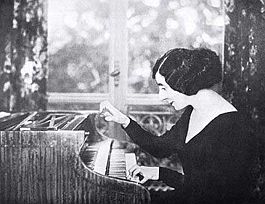
Born: July 5, 1879 Warsaw, Russian partition of Poland (presently capital of Poland)
Died: August 16, 1959, Lakeville, Connecticut, USA
Opinions. She was a harpsichordist whose performances, teaching, recordings and writings played a large role in reviving the popularity of the harpsichord in the early 20th century. She was the first person to record Bach's Goldberg Variations on the harpsichord (1931). A wonderful interpreter of the Baroque masters, Landowska often played Chopin in the privacy of her Connecticut home. When begged by friends to play Chopin in public she refused, preferring instead to keep this little bit of Poland to herself. It was her precious link with the early days in Warsaw which she could not bring herself to share with the world.
Early days. Landowska was born in Warsaw, where her father was a lawyer, and her mother a linguist who translated Mark Twain into Polish. She began playing piano at the age of four, and studied at the Warsaw Conservatory with Jan Kleczynski and Aleksander Michalowski. She also studied composition with Heinrich Urban in Berlin.
Professional career. After marrying the Polish folklorist Henry Lew in 1900 in Paris, she taught piano at the Schola Cantorum there (1900-1912). She had a strong predilection for the music of Bach in her earliest piano recitals. She began to tour widely as a pianist and, increasingly, as a harpsichordist. In 1909, on a tour of Russia, she played for the writer Count Lev Tolstoi. Her husband assisted her in her intense study of musical style and interpretation of the seventeenth and eighteenth centuries. She focused on reviving the harpsichord as a living concert and recital instrument, becoming an ancestor of the "original instruments" and "authentic performance" movements of the twentieth century. In 1912, she commissioned the Pleyel piano manufacturing firm to construct the first of many harpsichords built to her specifications. She later taught harpsichord at the Berlin Hochschule fuer Musik (1912-1919). Deeply interested in musicology, and particularly in the works of Bach, Couperin and Rameau, she toured the museums of Europe looking at original keyboard instruments; she acquired old instruments and had new ones made at her request by Pleyel and Company. These were large, heavily-built harpsichords with a 16-foot stop (a set of strings an octave below normal pitch) and owed much to piano construction. Responding to criticism by fellow harpsichordist Rosalyn Tureck, she once said: "You play Bach your way, and I'll play him his way." At the end of WWI her husband was killed in an automobile accident in Berlin. Soon after, she played the continuo part in a performance of Bach's St. Matthew Passion in Basel, the first time in that century that the harpsichord was used in the performance of the great work. Landowska had become convinced that only the harpsichord was truly appropriate to the Baroque and early Classical periods. She began teaching at the Basel Conservatory in 1919 and then returned to teach in Paris. She toured the United States for the first time in 1923, taking four Pleyel harpsichords with her. On this tour, she appeared with Leopold Stokowski and the Philadelphia Orchestra, making her first acoustic recordings. A number of important new works were written for her: Manuel de Falla's El retablo de maese Pedro marked the return of the harpsichord to the modern orchestra. Falla later wrote a harpsichord concerto for her, and Francis Poulenc composed his Concert champ�tre for her. She established the �cole de Musique Ancienne at Paris in 1925: from 1927, her home in Saint-Leu-la-For�t became a center for the performance and study of old music. When Germany invaded France, the Jewish Landowska escaped with her assistant and companion Denise Restout, leaving Saint-Leu in 1940, sojourning in southern France, and finally sailing from Lisbon to the United States. She arrived in New York on December 7, 1941. The house in Saint-Leu was looted, and her many harpsichords and a library of 10,000 volumes stolen, so she arrived in the United States essentially without assets. She settled in Lakeville, Connecticut in 1949 and re-established herself as a performer and teacher in the United States, touring extensively. Her life companion Denise Restout was editor and translator of her writings on music, including Musique ancienne, and Landowska on Music. After the death of Landowska in1959, Denise Restout began an annual musical afternoon on the anniversary, which continued for many years. Here, in the house on a hill, many students from different countries would gather and the house would ring with conversations in English, French and Polish. One after another the students would approach the piano or harpsichord and begin to play some Bach or Couperin to the delight of the non-performing guests.
Bibliography: W. Landowska and Henri Lew-Landowski : Musique Ancienne (1996)
W. Landowska: Landowska on Music (1964)
Denise Restout: translation of Landowska on music (1964);
Documentary film, Landowska: Uncommon Visionary (1997), dir. by B. Attie.
Awards. Wanda Landowska was the recipient of the French Legion d'Honneur for her contribution to the world of music, as well as many other awards and recognitions.
Source;
Based, with modifications and supplements, on an article from Wikipedia:
Wikipedia
All text is available under the terms of the GNU Free Documentation License.
Other sources:
http://www.amazon.com/s/qid=1220838852/ref=sr_pg_2?ie=UTF8&rs=1000&rh=i%3Astripbooks%2Cp_27%3AWanda%20Landowska&page=2 Landowska's numerous publications
You Tube: listen to and watch Landowska's home movie
Answers.com
Suite101.com
Return to home page:
Prominent Poles